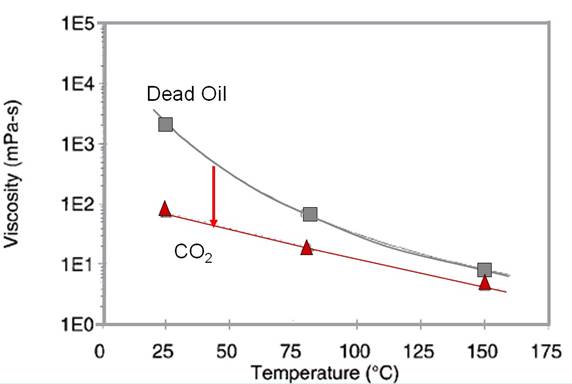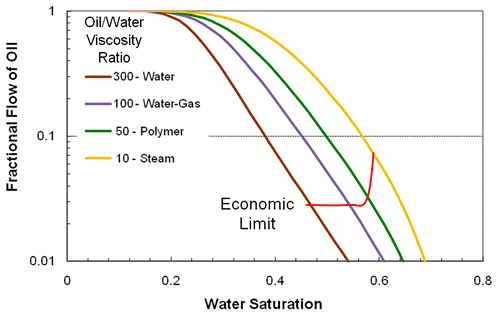  |
|
Petroleum and Chemical Consulting and Modeling for Enhanced Oil Recovery |
|---|---|---|
Houston, TX - Phone: (281) 564 - 8851 |
||
Simplified Enhanced Oil Recovery Theory |
||
|
This section presents a very simple explanation of EOR that will help show similarities between EOR techniques. This explanation is based on the statement that “All EOR techniques are simply improving the mobility of oil and injecting a fluid to repressurize the reservoir.” |
|
Effect of Carbon Dioxide on Heavy-Oil Viscosity |
||
|
||
The flow of fluids in porous media is governed by Darcy’s law: |
||
Flow rate = k/μ·ΔΡ/ΔL |
||
The ratio of the flow rates of water and oil (WOR) is: |
||
(kw/ko)·(μo/μw) |
||
The fractional flow of oil (foil) is: |
||
1/(1+WOR) |
||
The last relationship can be used to show how effective several improved oil recovery techniques will be. This is shown in the figure below where fractional flow of oil is plotted for several viscosity ratios (μo/μw) of oil to water versus the water saturation for several oil recovery techniques. The first line (left) on the graph is for water displacing oil (μo/μw 300). This line crosses the economic limit line (3% oil cut) at 48% water saturation, i.e., 45% of the oil is recovered in a completely swept zone. The second line is for water and gas displacing the oil. Now, the viscosity of the oil has been reduced by a factor of 3 (μo/μw100), and the economic limit is at 54% water saturation. This means that 61% of the oil has been displaced in a swept zone. The third curve is for μo/μw of 50, a polymer flood with no adsorption. Now, the curve moves farther to the right but the economic limit rises because polymer costs approximately USD 0.7/barrel of injected water. |
||
Effect of Viscosity Ratio on Fractional Flow of Oil |
||
|
||
Likewise, when the oil is heated with steam, which costs USD 2-3.50 per barrel to make, the economic limit also rises, so that polymer and steam might recover 68% and 73% of the oil in a swept zone, respectively. Now, oil heated by steam generated with in situ-combustion may only cost USD 0.74/bbl, so the economic limit would be higher than that of steam and in-situ combustion could be an attractive EOR technique. |
||

